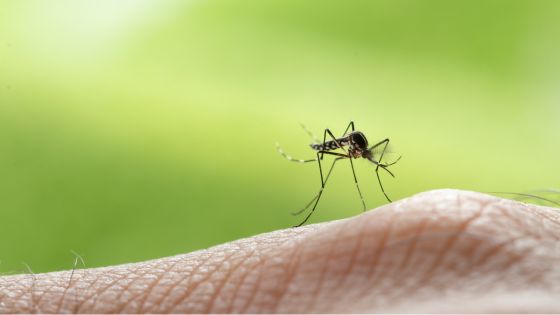As an expert in mosquito misting systems in Tampa and the Tampa Bay area, A-Niks is keeping abreast of what medical experts and epidemiologists warn people about. Mosquitoes pose serious challenges for public health, and Floridians must be aware of the need to control the mosquito population in their own backyards.

Disclaimer: We are not medical experts. We rely on CDC data to tell us what the risks are, and how they impact our region.
What are the most common mosquito species in Florida and the Southeastern United States?
Our region is home to various mosquito species, some of which more prevalent and medically significant than others.
A) Yellow Fever Mosquito (aedes aegypti): Aedes aegypti is a particularly concerning species due to its ability to transmit diseases such as dengue fever, chikungunya, and Zika virus. It thrives in urban environments and is known for its daytime biting habits.
B) Asian Tiger Mosquito (aedes albopictus): the population of aedes albopictus is significant in Florida and the southeastern states. This species is capable of transmitting diseases like dengue fever, chikungunya, Zika virus, and West Nile virus. It is aggressive and bites both during the day and at night.
C) Southern House Mosquito (culex quinquefasciatus): This species is prevalent in Florida and the humid regions of the southeastern United States. It is a vector for West Nile virus, St. Louis encephalitis, and lymphatic filariasis. It is most active during dusk and dawn.
D) Anopheles quadrimaculatus: This mosquito species is responsible for transmitting malaria. While malaria is not endemic in the southeastern states, these mosquitoes can be found in some areas and pose a potential risk to individuals who have traveled to malaria-endemic regions.
What health risks are associated with mosquito bites?
Mosquito bites are a health riskdue to the transmission of pathogens from the mosquitoes’ saliva into the human bloodstream through the action of biting. Some of the mathogens include:
A) West Nile virus (WNV): Over the past two decades, the southeastern United States has experienced multiple epidemics of West Nile virus. This viral infection can cause symptoms ranging from mild, flu-like illness to severe neurological complications, such as encephalitis and meningitis.
B) Dengue fever: While dengue fever is more commonly associated with tropical regions, Florida and the southeastern United States have seen occasional outbreaks in recent years. Symptoms of dengue fever include high fever, severe headache, joint and muscle pain, rash, and in severe cases, hemorrhagic fever.
C) Chikungunya: The Chikungunya virus, transmitted by Aedes mosquitoes, has caused outbreaks in the southeastern United States. Symptoms include high fever, joint pain, rash, and severe joint stiffness. Although rarely fatal, chikungunya can result in long-term joint pain and disability.
D) Zika virus: The Zika virus created an epidemic in 2015-2016 in parts of the southeastern states. Pregnant women infected with Zika virus are at risk of giving birth to babies with congenital Zika syndrome, which can cause severe birth defects, including microcephaly.
Recent epidemics in Florida and the southeastern states
In the past 20 years, epidemics related to mosquito-borne diseases in our region have highlighted how important it is to understand and address these health risks. A few notable examples:
A) West Nile virus (WNV) epidemics: Since its introduction to the United States in 1999, the West Nile virus has caused several epidemics in our regions. In 2002, an outbreak occurred in Louisiana, leading to hundreds of human cases and numerous deaths. Subsequent outbreaks have been reported in Mississippi, Alabama, and Florida. These epidemics have served as a reminder of the potential severity of West Nile virus infection and the need for effective mosquito control measures.
B) Zika Virus epidemic: The southeastern states experienced a Zika virus epidemic in 2015. Florida saw localized outbreaks, particularly in Miami-Dade County in 2016. The Zika virus was primarily transmitted by Aedes mosquitoes, with concerns raised about its association with microcephaly and other birth defects.
C) Chikungunya outbreak: the Chikungunya virus, transmitted by Aedes mosquitoes, caused a notable outbreak in Florida in 2014. Cases of the outbreak were also reported in other states. The epidemic highlighted the rapid spread of the virus and the potential for local transmission in areas with competent mosquito vectors. Efforts were made to control mosquito populations and educate the public about prevention measures.
D) Dengue fever outbreaks: These outbreaks have occurred sporadically in Florida and the southeastern statesin 2009, 2010, and 2013. They involved both local transmission and imported cases. The authorities implemented mosquito control measures, public awareness campaigns, and surveillance systems to detect and respond to cases promptly.
About A-Niks: A-Niks designs and builds mosquito misting systems for residential and commercial clients in Florida since 2004. Headquartered in Tampa, the company has grown from a small family project to become a major installer of misting machines for mosquito control with installations from Daytona to Miami. A-Niks has developed its own natural insecticide solution, based on plants known as mosquito repellents. A-Niks also offers home mosquito spray services.
